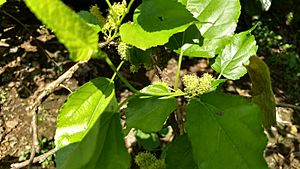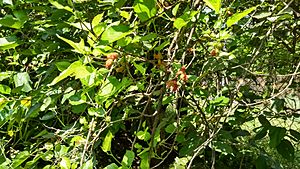Morus indica facts for kids
Quick facts for kids Morus indica |
|
|---|---|
 |
|
| Morus indica with unripe berries | |
| Scientific classification | |
| Genus: |
Morus
|
| Species: |
indica
|
Morus indica is a type of mulberry tree, part of the Morus family. Like other mulberries, it's a deciduous tree, which means it loses its leaves every year. This plant originally comes from the cool and warm parts of the Himalayan region. Today, you can find it growing in countries like India, China, Japan, and parts of East Africa.
About the Morus indica Tree
Morus indica is usually a small tree or a shrub. It rarely grows taller than about 10 to 15 meters (around 33 to 49 feet). When the branches are young, they have soft, fine hairs. But as the plant gets older, these hairs disappear. The branches themselves are a light gray-brown color.
Leaves of the Mulberry Tree
The leaves of Morus indica are usually between 4 and 12.5 centimeters (about 1.5 to 5 inches) long and 2.5 to 7.5 centimeters (about 1 to 3 inches) wide. They are attached to the tree by small stems called petioles. The leaves often have an oval shape, but sometimes they can be lobed, meaning they have rounded sections. They come to a narrow point at the end. The base of the leaf is usually slightly heart-shaped. The edges of the leaves have small, sharp teeth. The top of the leaf is dark green, while the underside is paler and covered in fine hairs.
Flowers and Berries
Morus indica is a special kind of flowering plant because it has both male and female flowers on the same tree. Sometimes, these different flowers grow on separate branches. The male flowers grow in narrow clusters, about 9 to 11.5 millimeters (around 0.35 to 0.45 inches) long, and are covered in fine hairs. The female flowers are almost round, measuring about 6 to 9.5 millimeters (around 0.24 to 0.37 inches) long.
After a female flower is fertilized, it grows into a juicy, compound fruit called a syncarp. This fruit looks a lot like the black mulberry fruit, and it turns black when it's fully ripe and ready to eat!


